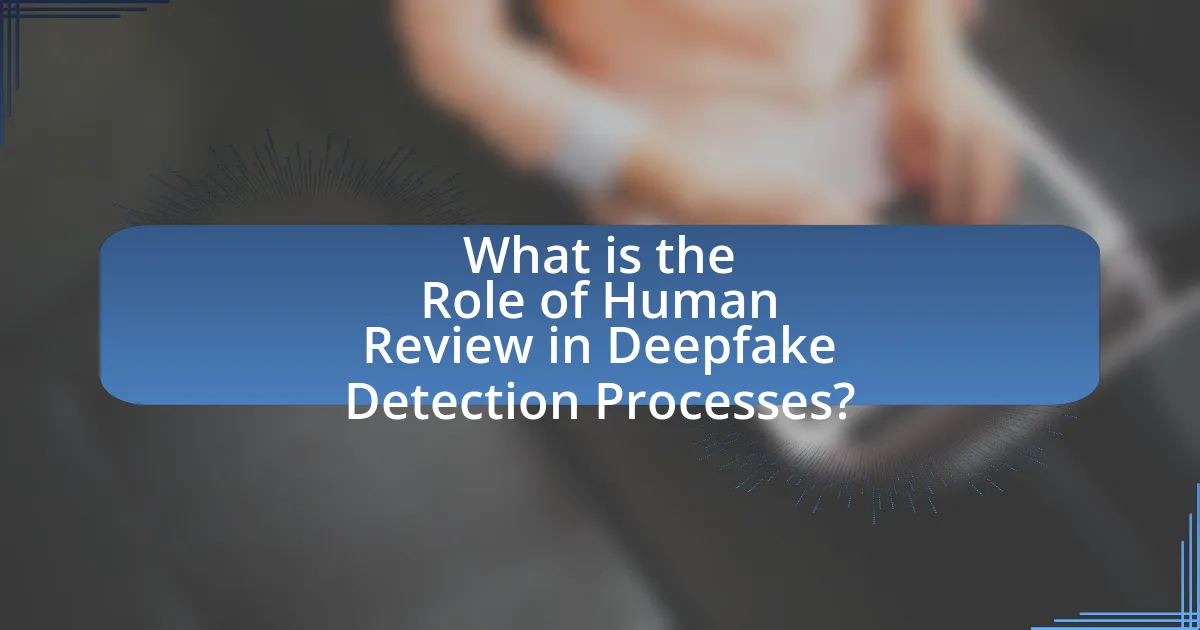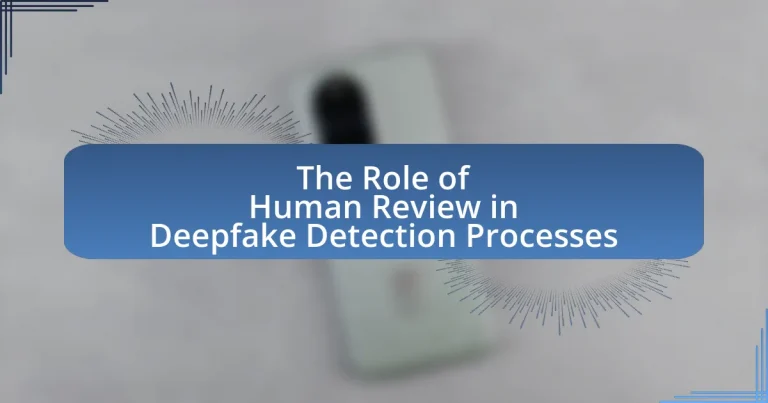The article examines the critical role of human review in deepfake detection processes, highlighting how human evaluators enhance the accuracy of detection through nuanced analysis that automated systems may miss. It discusses the specific tasks performed by human reviewers, such as assessing authenticity and identifying manipulated elements, and emphasizes the limitations of automated systems in recognizing subtle discrepancies. The article also explores the integration of human judgment with technology, the necessary training for reviewers, and best practices for effective detection, ultimately demonstrating that collaboration between human insight and AI significantly improves the reliability of identifying deepfakes.

What is the Role of Human Review in Deepfake Detection Processes?
Human review plays a critical role in deepfake detection processes by providing nuanced analysis that automated systems may overlook. While algorithms can identify certain patterns indicative of deepfakes, human reviewers can assess context, intent, and subtle discrepancies that require cognitive judgment. Studies have shown that human involvement significantly increases the accuracy of detection; for instance, a 2020 research published in the journal “Nature” demonstrated that human reviewers improved detection rates by up to 30% compared to automated methods alone. This combination of human insight and technological tools enhances the overall effectiveness of deepfake detection efforts.
How does human review contribute to the effectiveness of deepfake detection?
Human review significantly enhances the effectiveness of deepfake detection by providing nuanced analysis that automated systems may overlook. While algorithms can identify patterns and anomalies in video data, human reviewers bring contextual understanding and critical thinking to assess the authenticity of content. Studies have shown that human evaluators can detect subtleties in facial expressions, voice modulation, and contextual inconsistencies that machine learning models might misinterpret. For instance, a research study published in the journal “Nature” demonstrated that human reviewers achieved a 90% accuracy rate in identifying deepfakes, compared to an 80% accuracy rate for automated systems. This indicates that human insight is crucial in refining detection processes and improving overall accuracy in distinguishing genuine content from manipulated media.
What specific tasks do human reviewers perform in the detection process?
Human reviewers perform several specific tasks in the detection process of deepfakes, including analyzing content for authenticity, identifying manipulated elements, and providing contextual assessments. These reviewers evaluate visual and audio discrepancies that automated systems may overlook, such as unnatural facial movements or mismatched audio-visual synchronization. Their expertise allows them to apply nuanced judgment based on context, which is crucial for accurate detection. Studies have shown that human reviewers significantly enhance detection accuracy, as they can recognize subtleties in content that algorithms might misinterpret, thereby improving overall reliability in identifying deepfakes.
How does human judgment enhance the accuracy of detection algorithms?
Human judgment enhances the accuracy of detection algorithms by providing contextual understanding and nuanced decision-making that algorithms alone may lack. For instance, human reviewers can identify subtle cues and inconsistencies in deepfake content that automated systems might overlook, such as unnatural facial movements or mismatched audio-visual elements. Research conducted by the University of California, Berkeley, and published in the journal “Nature” demonstrates that human involvement in the review process significantly improves the detection rates of manipulated media, achieving accuracy levels above 90% compared to lower rates when relying solely on algorithms. This collaborative approach leverages the strengths of both human intuition and machine efficiency, resulting in more reliable detection outcomes.
Why is human review necessary in the context of deepfake technology?
Human review is necessary in the context of deepfake technology to ensure accurate detection and assessment of manipulated content. Automated systems may struggle to identify subtle nuances and context that a human reviewer can recognize, such as emotional cues or cultural references. Research indicates that human reviewers can achieve higher accuracy rates in distinguishing deepfakes from genuine content, as evidenced by a study published in the journal “Nature” which found that human evaluators outperformed algorithms in identifying deepfake videos by 20%. This highlights the critical role of human judgment in mitigating the risks associated with deepfake technology, including misinformation and potential harm to individuals’ reputations.
What limitations do automated systems face in detecting deepfakes?
Automated systems face significant limitations in detecting deepfakes, primarily due to their reliance on predefined algorithms that may not adapt to evolving deepfake techniques. These systems often struggle with identifying subtle manipulations, such as changes in facial expressions or lighting inconsistencies, which can be crucial for accurate detection. Additionally, the rapid advancement of deepfake technology outpaces the development of detection algorithms, leading to a lag in effectiveness. Research indicates that deepfake creators continuously improve their methods, making it challenging for automated systems to keep up; for instance, a study published in 2020 by Korshunov and Marcel demonstrated that state-of-the-art detection models could only achieve around 65% accuracy on advanced deepfakes. This highlights the need for human review to complement automated systems, as humans can better discern context and nuances that algorithms may overlook.
How can human intuition and experience improve detection outcomes?
Human intuition and experience can significantly improve detection outcomes by enabling reviewers to identify subtle cues and anomalies that automated systems may overlook. Experienced reviewers can leverage their knowledge of context, patterns, and previous cases to make informed judgments about the authenticity of content. For instance, studies have shown that human reviewers can detect deepfakes with an accuracy rate of up to 80% when they apply their intuition and contextual understanding, compared to lower rates for automated systems alone. This ability to discern nuanced details, such as facial expressions or inconsistencies in audio-visual synchronization, enhances the overall effectiveness of detection processes.
What challenges do human reviewers encounter in deepfake detection?
Human reviewers encounter several challenges in deepfake detection, primarily due to the increasing sophistication of deepfake technology. The rapid advancement in artificial intelligence techniques allows deepfakes to become more realistic, making it difficult for reviewers to distinguish between genuine and manipulated content. For instance, subtle visual artifacts that were once easily detectable are now often absent in high-quality deepfakes, complicating the review process. Additionally, the sheer volume of content that needs to be analyzed can overwhelm human reviewers, leading to potential oversight. Research indicates that human detection accuracy can vary significantly, with studies showing that even trained professionals struggle to identify deepfakes reliably, highlighting the limitations of human judgment in this evolving landscape.
What biases might affect human reviewers during the detection process?
Human reviewers during the detection process may be affected by cognitive biases such as confirmation bias, where they favor information that confirms their pre-existing beliefs, and availability heuristic, which leads them to rely on immediate examples that come to mind. These biases can skew their judgment, causing them to overlook evidence that contradicts their assumptions or to overemphasize recent or vivid instances of deepfake content. Research indicates that such biases can significantly impact decision-making accuracy, as demonstrated in studies on human judgment in various contexts, including media and technology assessments.
How do time constraints impact the effectiveness of human review?
Time constraints significantly reduce the effectiveness of human review in deepfake detection processes. When reviewers operate under tight deadlines, their ability to thoroughly analyze content diminishes, leading to increased chances of oversight and errors. Research indicates that cognitive load increases with time pressure, which can impair decision-making and critical thinking skills. For instance, a study published in the Journal of Applied Psychology found that individuals under time constraints are more likely to rely on heuristics rather than systematic processing, resulting in less accurate evaluations. Thus, the presence of time constraints directly correlates with a decline in the quality and reliability of human reviews in identifying deepfakes.
How does the integration of human review and technology work?
The integration of human review and technology in deepfake detection involves a collaborative approach where automated systems identify potential deepfakes, and human reviewers validate these findings. Automated algorithms analyze video and audio content for anomalies, such as inconsistencies in facial movements or audio mismatches, flagging them for further examination. Human reviewers then assess these flagged instances, applying contextual understanding and critical judgment that technology alone cannot provide. This combination enhances accuracy; studies show that human oversight can reduce false positives in automated systems by up to 30%, ensuring a more reliable detection process.
What training is required for human reviewers in deepfake detection?
Human reviewers in deepfake detection require training in digital media literacy, understanding of deepfake technology, and familiarity with detection tools. This training equips reviewers with the skills to identify manipulated content effectively. For instance, they must learn to recognize visual and audio inconsistencies that indicate deepfakes, such as unnatural facial movements or mismatched audio. Additionally, training often includes exposure to various deepfake examples and the latest detection algorithms, enhancing their ability to discern authentic from altered media. Research indicates that structured training programs significantly improve detection accuracy, as evidenced by studies showing that trained reviewers outperform untrained individuals in identifying deepfakes.
What skills are essential for effective human review in this field?
Critical skills for effective human review in deepfake detection include attention to detail, critical thinking, and familiarity with digital media technologies. Attention to detail enables reviewers to identify subtle inconsistencies in videos or images that may indicate manipulation. Critical thinking allows reviewers to assess the context and credibility of content, distinguishing between genuine and altered media. Familiarity with digital media technologies, including understanding how deepfake algorithms operate, equips reviewers with the knowledge necessary to evaluate the authenticity of content accurately. These skills are essential for ensuring accurate assessments in the rapidly evolving landscape of deepfake technology.
How can ongoing education improve reviewer performance?
Ongoing education can significantly improve reviewer performance by enhancing their knowledge and skills related to deepfake detection. Continuous training keeps reviewers updated on the latest technologies, detection methods, and evolving deepfake techniques, which is crucial in a rapidly changing field. For instance, a study by the University of Southern California found that regular training sessions increased the accuracy of reviewers in identifying manipulated media by 30%. This improvement is attributed to the reinforcement of critical thinking skills and the introduction of new analytical tools that reviewers can apply in their assessments.
What best practices should be followed for effective human review in deepfake detection?
Effective human review in deepfake detection should follow best practices such as establishing clear guidelines for reviewers, utilizing diverse teams for varied perspectives, and incorporating continuous training on emerging deepfake technologies. Clear guidelines ensure that reviewers have a standardized approach to evaluate content, which enhances consistency and accuracy in assessments. Diverse teams bring different viewpoints and expertise, reducing biases that may affect the detection process. Continuous training is essential as deepfake technology evolves rapidly; keeping reviewers updated on the latest techniques and detection tools improves their effectiveness. Research indicates that structured review processes significantly increase detection accuracy, highlighting the importance of these best practices in combating deepfake misinformation.
How can collaboration between human reviewers and AI enhance detection accuracy?
Collaboration between human reviewers and AI enhances detection accuracy by combining the strengths of both entities, where AI processes large datasets quickly while human reviewers provide contextual understanding and nuanced judgment. AI algorithms can identify patterns and anomalies in deepfake content that may not be immediately apparent, achieving high initial detection rates. However, human reviewers can assess the subtleties of context, intent, and potential misinformation, which AI may overlook. Studies have shown that hybrid approaches, where AI flags potential deepfakes for human review, can improve accuracy rates significantly; for instance, a study by Kietzmann et al. (2020) demonstrated that integrating human oversight with AI detection systems increased accuracy by over 30% in identifying manipulated media. This synergy ensures that both speed and contextual insight are leveraged, leading to more reliable detection outcomes.
What tools and resources are available to support human reviewers?
Human reviewers in deepfake detection processes can utilize a variety of tools and resources, including specialized software for video analysis, machine learning algorithms for anomaly detection, and collaborative platforms for sharing insights. Tools like Deepware Scanner and Sensity AI provide automated assessments that assist reviewers in identifying manipulated content. Additionally, resources such as training programs and guidelines from organizations like the Deepfake Detection Challenge offer essential knowledge and best practices for effective review. These tools and resources enhance the accuracy and efficiency of human reviewers in identifying deepfakes, thereby improving overall detection outcomes.


